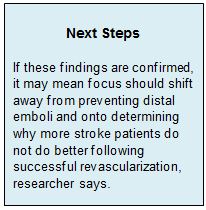Key Points:
- Single-center study looks at distal emboli before, after mechanical thrombectomy for acute ischemic stroke
- New distal emboli found in 15% of patients but not associated with negative outcomes
Nearly 1 in 6 patients treated with mechanical thrombectomy for acute ischemic stroke develop new distal emboli, but their clinical outcomes appear unaffected, according to a small series published in the February 2016 issue of Neurosurgery.
Philipp Taussky, MD, of the University of Utah (Salt Lake City, UT), and colleagues reviewed cerebral angiograms of all 39 patients (mean age 61 years; 54% men) treated at their center with the Solitaire device (Covidien/ev3) between 2012 and 2013. The investigators compared angiographic microcatheter runs before deployment of the device and after thrombectomy to identify new distal filling defects.
Successful revascularization occurred in 92% of patients. Three distinct angiographic patterns associated with distal emboli were identified:
- New distal emboli in the same vascular territory (n = 3)
- New distal emboli in a new vascular territory (n = 3)
- Distal emboli that resolved after proximal revascularization (n = 7)
In addition, 13 patients had distal emboli before and after Solitaire runs, and 13 showed no evidence of distal emboli.
Favorable outcome, defined as a modified Rankin Scale (mRS) score of 0-2, was obtained by 54% of all patients and 83% of patients was seen in 54% of all patients and 83% of patients with new distal emboli. There was no association between new emboli and unfavorable clinical outcome (P = .67).
Patients were less likely to have an mRS of 0-2 at 90 days if they had distal filling defects on both pre- and post-Solitaire runs (50%), compared with patients who had pre-Solitaire distal filling defects that resolved on the post-Solitaire run (17%). This difference did not reach statistical significance, however (P = .53).
Typical but Avoidable
In a telephone interview with WLNCMD, Dr. Taussky noted that their 15% rate of new emboli with the Solitaire device is not far off from what has been seen in other reports, whose rates usually range from 6% to 12%. It is no surprise that they identified perhaps a slightly higher rate of new distal emboli, given they were looking specifically for them using a novel approach and carefully exploring each and every vessel, he said.
In an email to WLNCMD, Kai Kallenberg, MD, of the Universtitätsmedizin Göttingen (Göttingen, Germany), concurred. “Ischemic events—including emboli—in the treatment of acute stroke are typical,” he said. While distal emboli are frequently not of clinical concern, “it is possible that eloquent areas might be affected.”
Dr, Taussky said that “tricks” for reducing the occurrence of distal emboli include using a balloon-guided catheter, which does not produce forward flow. There is also the possibility of adding an aspiration system to induce flow reversal.
According to Dr. Kallenberg, use of intermediate catheters can also lower the risk of distal emboli, and he pointed out that a lower rate of distal emboli was seen for the Aperio thrombectomy device (Acandis) in a phantom study comparing it with Solitaire.
Many new tools are currently under development that are designed to reduce distal emboli risk, Dr. Taussky said. This is because, intuitively, the fewer distal emboli, the better. It is notable, therefore, that this study did not find any negative clinical sequelae associated with their presence.
A larger series will be needed to confirm these findings, he noted. If the lack of harm is conformed, it may be that focus needs to shift away from preventing distal emboli and on to issues of more clinical significance. “If you look at all stroke trials, the revascularization rate is very high, usually 80% to 90%, but good clinical outcomes only occur in about 40% to 50% of cases. We still don’t understand why patients don’t do better,” Dr. Taussky stressed.
Source:
Mazur MD, Kilburg C, Park MS, et al. Patterns and clinical impact of angiographically visible distal emboli during thrombectomy with solitaire for acute ischemic stroke. Neurosurgery. 78:242-250.
Disclosures:
- Dr. Kallenberg reports no relevant conflicts of interest.
- Dr. Taussky reports consulting for Medtronic.


